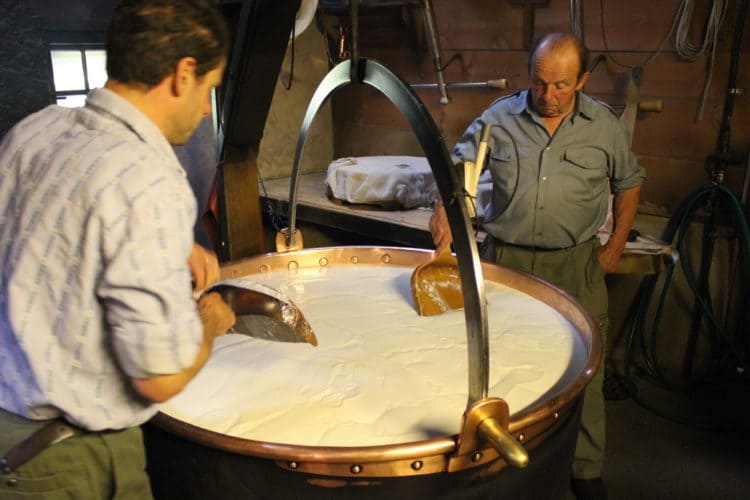
Father-and-son team Germain and Béat Piller make Gruyère cheese on an alpage near Charmey, Switzerland. Photo Credit: Molly McDonough
IN the early morning on a select few alpages dotting the hills of Switzerland’s Gruyères region, cheesemakers light a wood fire under a milk-filled copper pot. As milk turns to curd, they control the cauldron’s temperature with impressive precision by swinging it on and off the flames. Here in huts surrounded by high-altitude pastures, modern stainless-steel vats seem very far away.
There’s something especially rustic about copper, an element discovered by Neolithic communities around 9000 B.C., when agriculture was still in its nascent stages. Back then the ductile substance replaced stone as the tool-making material of choice—until it became clear that mixing and melding it with tin yielded an even stronger alloy better suited for weapons and utensils, ushering in the Bronze Age. Still, copper’s thermal conductivity—more than 20 times more efficient than stainless steel—firmly established the auburn element in one place: the kitchen.
Wherever Gruyère is produced, you’ll find it; if a cheese isn’t made in copper, it can’t be called Gruyère. “It’s an obligation based on the history of our product,” says Thierry Bize, quality director of the organization that oversees the cheese’s AOP (Appellation d’Origine Protégée) status. This Alpine wheel isn’t the only one to preserve that tradition: Regulations for Swiss Emmentaler, Sbrinz, and Raclette, French Comté, and Italian staple Parmigiano Reggiano, among many others, also mandate use of copper vats.
According to recent experiments, there are reasons beyond history to keep the practice alive. In 2009, scientists at the Università Cattolica del Sacro Cuore in Piacenza, Italy, crafted eight batches of cheese following a Parmigiano Reggiano recipe: four in copper vats, four in stainless-steel vats. After maturing 17 months, all wheels shared a similar exterior appearance, plus comparable levels of fat, protein, and moisture. When they were cracked open, however, defects emerged. The stainless steel-made wheels had interior fissures and a strangely elastic paste. Taste tests revealed another discrepancy: Those cheeses simply weren’t as flavorful or aromatic.
Differences between the two batches first emerged during production. Just like the process for most Alpine wheels, the recipe for Parmigiano Reggiano calls for cooking curds after they’ve been cut to expel whey and prevent an unwanted surface film. This step requires rapid and uniform transmission of heat from vat to curd—and a similarly speedy cooling afterwards.
“When you put something into stainless steel, it heats wherever the steam is injected into it,” says Master Cheesemaker Bruce Workman of Edelweiss Creamery, who has used copper vats for decades to create Alpine-style cheeses in Monroe, Wis. “That’s the hot spot. But copper heats up equally throughout. It heats fast, it heats evenly, and it cools fast.”
Sure enough, when the Italian scientists reviewed the log, they noticed that copper vat temperatures had increased much more quickly, suggesting that the traditional vessels are necessary to achieve a desired result.
There was another difference in the finished cheeses. Wheels made in copper vats contained a higher copper content—5.78 milligrams per kilogram (mg/kg)—versus 0.40 mg/kg in the stainless steel–produced wheels. Previous studies of Alpine cheeses reveal a similar pattern: In 1996, scientists found 12.7 mg/kg of the element in Comté when copper vessels were used yet only 3 mg/kg when they were not. Gruyère usually contains anywhere from 7.6 to 11.7 mg/kg of copper. The reason? Soft, supple copper oxidizes easily. During cheesemaking, then, copper ions leach from the vat and bind to milk proteins, which remain in the cheese.
Evidence suggests that an elevated copper content likely has an effect on flavor and texture. In Finland, emmental (a cheese modeled after Emmentaler) is popular. Because Finnish producers aren’t subject to Swiss AOP rules, they hardly ever use copper vats. In 2011, researchers at the University of Helsinki added copper directly to the milk before making emmental in stainless-steel vats. After aging three months, the copper-supplemented cheeses scored higher among expert taste testers.
The additive likely influences a cheese’s microflora. Like iodine and iron, copper is a trace element affecting the health of all living things. Consuming a certain amount is essential for life, but too little or too much can have harmful effects—on humans and microbes alike. The Finnish researchers discovered that copper inhibited the growth of C. tyrobutyricum, bacteria often present in raw milk that generate undesired swelling, gas holes, and off-flavors in hard cheeses. Ernst Jakob, a researcher at Agroscope in Switzerland, has found similar effects on Swiss cheeses made with raw milk. “Copper stops the development of bacteria responsible for rancid taste,” he says.
Since different microorganisms have different thresholds for tolerating the element, copper levels could discourage the growth of some species while promoting the proliferation of others. But even as scientists are unraveling these complex biochemical reactions, Edelweiss Creamery’s Workman is adamant the vats provide the ideal ecosystem for the microbes he uses. “Because of its natural ability to influence the cultures,” he says, “copper adds the right flavor profile.”
Spring Brook Farm in Reading, Vt., uses copper vats to craft Alpine-style wheels. On past trips abroad, cheesemaker Jeremy Stephenson has asked his European counterparts about the practice, only to receive vague answers. But he’s sure the element will endure, mainly because the cheese recipes that inspire him were developed carefully over thousands of years and perfected in copper cauldrons.
“In that way, it is just part of the cheese’s identity,” he says. For Stephenson, that’s reason enough.
Feature Photo: Father-and-son team Germain and Béat Piller make Gruyère cheese on an alpage near Charmey, Switzerland. Credit: Molly McDonough.



